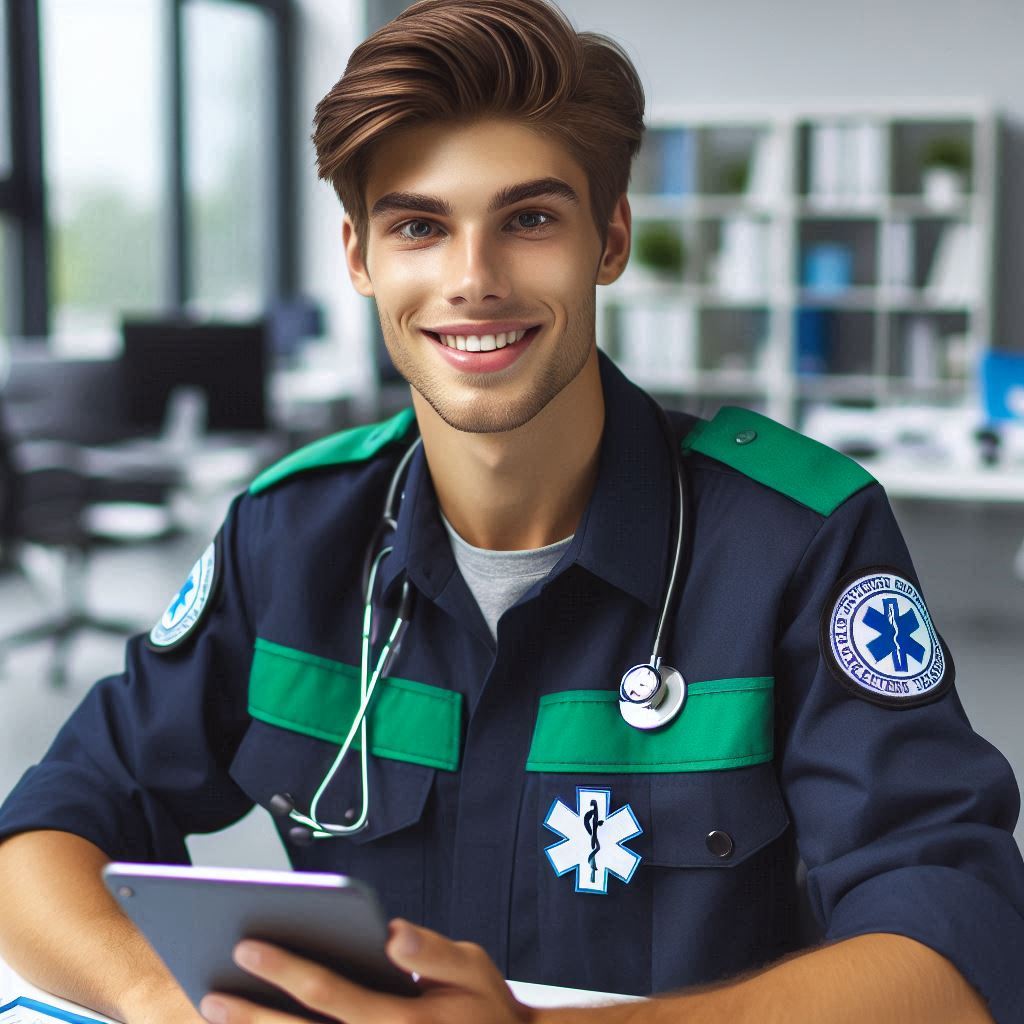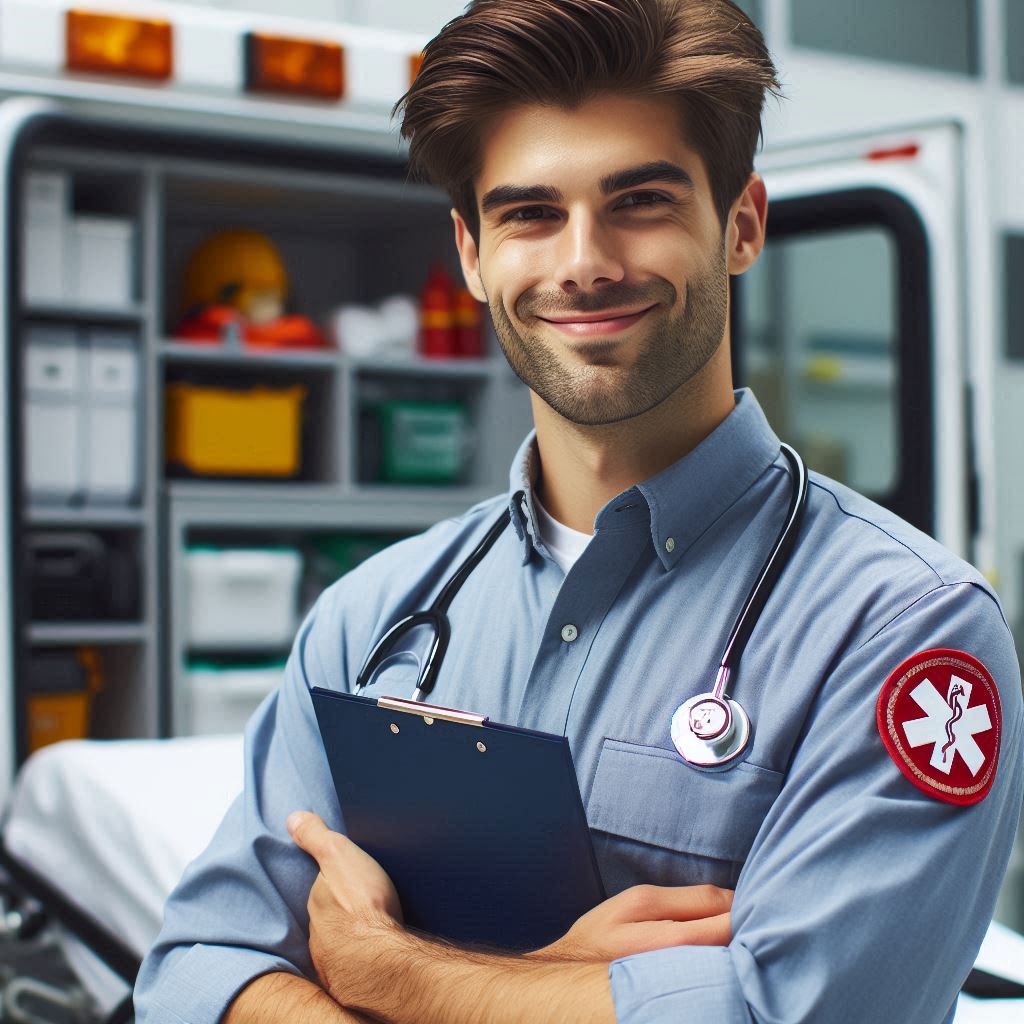Introduction
Emergency Medical Technicians (EMTs) are frontline healthcare professionals trained to deliver immediate medical care in crises.
They swiftly assess patients’ conditions, administer vital treatments, and transport individuals to hospitals for further care.
EMTs play a pivotal role in stabilizing patients during critical moments, often serving as the first point of contact in emergencies.
Their rapid response and expert medical interventions can make a life-saving difference, especially in situations like cardiac arrests, accidents, or severe injuries.
The importance of EMTs cannot be overstated in ensuring timely medical assistance where every second counts.
Their ability to apply life-saving techniques such as CPR, administering medications, and managing trauma injuries can significantly improve patient outcomes.
EMTs work under intense pressure, relying on their training and quick decision-making skills to prioritize and deliver appropriate care swiftly and effectively.
In emergency situations, their actions can mean the difference between life and death, highlighting the critical nature of their role in the healthcare system.
Stay tuned to explore a typical workday in the life of an Emergency Medical Technician, where we delve into the challenges they face, the skills they employ, and the impact they make on the lives of individuals in need of urgent medical attention.
Morning Routine
Start of shift at the emergency medical services station
As an Emergency Medical Technician (EMT), the day typically begins early, usually around 6:00 am.
The first order of business is reporting to the emergency medical services (EMS) station.
This is where all ambulances are stationed, and where EMTs begin their shifts.
Briefing on any assignments or updates for the day
Upon arrival, EMTs gather for a briefing led by the shift supervisor. During this time, any assignments for the day are handed out, and any updates are shared.
It is essential to pay close attention during this briefing as it sets the tone for the day ahead.
Once the briefing is completed, EMTs head to their assigned ambulance to begin their daily tasks.
One crucial task is checking and restocking medical supplies in the ambulance.
This ensures that all necessary equipment and medications are readily available for any emergencies that may arise throughout the day.
Checking and restocking medical supplies in the ambulance
Restocking the ambulance with medical supplies involves checking inventory levels of items such as bandages, gauze, syringes, medications, and other medical equipment.
Running out of supplies during an emergency is not an option, so this task is of utmost importance.
EMTs must restock the ambulance in an organized manner, ensuring that supplies are easily accessible and properly organized.
Transform Your Career Today
Unlock a personalized career strategy that drives real results. Get tailored advice and a roadmap designed just for you.
Start NowThis includes checking expiration dates on medications and disposing of any expired supplies.
By maintaining a well-stocked ambulance, EMTs are better prepared to respond to emergencies quickly and effectively.
In addition to restocking supplies, EMTs also perform routine maintenance checks on the ambulance itself.
This includes checking the vehicle’s fluids, lights, sirens, and other vital components to ensure that the ambulance is in proper working condition.
These checks are crucial for the safety of both the EMTs and the patients they transport.
Overall, the morning routine for an EMT is vital in preparing for the day ahead.
By starting the day with a well-stocked ambulance and a thorough briefing, EMTs are better equipped to handle any emergencies that come their way.
This routine sets the tone for a successful and productive shift as an emergency medical technician.
Read: EMT vs. Paramedic: Understanding the Differences
Responding to Emergency Calls
Receiving emergency calls from dispatch
As an Emergency Medical Technician (EMT), a typical workday usually starts with responding to emergency calls.
When the dispatcher alerts us to a medical emergency, we need to act fast and efficiently to provide life-saving assistance to those in need.
Upon receiving the emergency call from dispatch, we gather all necessary information about the situation and the location where we are needed.
The dispatcher instructs us on how to proceed and provides vital details that will help us prepare for the emergency response.
Quickly and safely driving to the location of the emergency
Jumping into the ambulance, we quickly and safely drive to the location of the emergency.
Time is of the essence in our line of work, so it’s crucial that we reach the scene as soon as possible.
We navigate through traffic and follow protocol to arrive at the destination promptly.
Once we reach the site of the emergency, we assess the situation to determine the severity of the patient’s condition.
This initial assessment helps us prioritize the necessary interventions and plan our course of action.
We remain calm under pressure, knowing that our quick response can make a significant difference in the outcome for the patient.
Assessing the situation and providing immediate medical care
Providing immediate medical care is our primary focus once we arrive at the scene.
Transform Your Career Today
Unlock a personalized career strategy that drives real results. Get tailored advice and a roadmap designed just for you.
Start NowWe stabilize the patient, administer first aid, and perform necessary procedures to address their medical needs.
Our training and expertise guide us in making critical decisions to ensure the patient receives the best possible care.
Every emergency call presents a unique set of challenges, and as EMTs, we must adapt to varying situations quickly.
Whether it’s attending to a car accident, responding to a heart attack, or assisting someone in respiratory distress, we are prepared to handle any medical emergency with skill and compassion.
In the fast-paced environment of emergency response, teamwork is essential.
EMTs work closely with paramedics, firefighters, and other healthcare professionals to coordinate patient care seamlessly.
Communication and collaboration are key to providing efficient and effective medical assistance in high-pressure situations.
Responding to emergency calls as an EMT is both physically and emotionally demanding.
We witness firsthand the impact of trauma and illness on individuals and their loved ones.
Despite the challenges, we find fulfillment in knowing that our dedication to saving lives can make a difference in our communities.
Being on the front line of emergency medical care requires unwavering commitment and a willingness to put others’ needs above our own.
The trust that people place in us during their most vulnerable moments motivates us to give our best each day.
As EMTs, we take pride in our ability to respond quickly to emergencies, provide critical care, and ultimately save lives.
Read: How to Become a Certified Emergency Medical Technician
Medical Assessments
As an Emergency Medical Technician (EMT), a typical workday is fast-paced and unpredictable.
One of the key responsibilities of an EMT is conducting medical assessments on patients to determine their condition and the appropriate course of action.
Conducting Initial Assessments
Upon arriving at the scene of an emergency, the EMT must quickly assess the situation and prioritize patients based on the severity of their condition.
The initial assessment involves evaluating the patient’s level of consciousness, airway, breathing, and circulation.
Taking Vital Signs
Once the initial assessment is complete, the EMT will take vital signs such as blood pressure, heart rate, respiratory rate, and temperature.
This information is crucial in determining the patient’s overall condition and response to treatment.
Transform Your Career Today
Unlock a personalized career strategy that drives real results. Get tailored advice and a roadmap designed just for you.
Start NowGathering Information
In addition to vital signs, EMTs gather information from patients or bystanders about the events leading up to the emergency.
This information helps in understanding the context of the situation and any pre-existing medical conditions that could be relevant.
Communicating Findings
After completing the medical assessments, EMTs communicate their findings to healthcare facilities such as hospitals or dispatch centers.
This information is essential for receiving further instructions on patient care and transportation to the appropriate medical facility.
In summary, conducting medical assessments is a critical aspect of an EMT’s workday.
It requires quick thinking, effective communication, and a thorough understanding of medical protocols to provide the best possible care to patients in emergency situations.
Read: Dietitian Career Transitions: Exploring New Roles

Administering Medical Treatment
As an Emergency Medical Technician (EMT), administering medical treatment is a crucial part of our daily responsibilities.
From performing life-saving procedures to providing comfort to patients, this aspect of our work is both demanding and rewarding.
Performing medical procedures
One of the most common tasks we perform as EMTs is CPR, which is often required in cases of cardiac arrest or respiratory distress.
This procedure involves chest compressions and rescue breaths to help restore the patient’s heartbeat and breathing.
It requires precision and skill, as every second counts in such critical situations.
Providing emotional support to patients and their families
In addition to CPR, we are also trained to bandage wounds and control bleeding.
Whether it’s a minor cut or a major trauma, our ability to quickly assess and treat injuries can make a significant difference in the patient’s outcome.
With proper training and equipment, we can effectively address a wide range of medical emergencies.
Administering medication is another important aspect of our job.
From pain relief to managing chronic conditions, EMTs are responsible for giving the right medications at the right time.
This requires careful attention to detail and adherence to established protocols to ensure patient safety and well-being.
Aside from the technical aspects of medical treatment, EMTs also play a crucial role in providing emotional support to patients and their families.
Dealing with emergencies can be a traumatic experience, and our compassionate presence can make a significant difference in how patients cope with their situation.
Transform Your Career Today
Unlock a personalized career strategy that drives real results. Get tailored advice and a roadmap designed just for you.
Start NowBy offering reassurance, empathy, and understanding, we help create a sense of calm and security in moments of crisis.
Collaborating with other healthcare professionals on complex cases
Furthermore, EMTs often collaborate with other healthcare professionals on complex cases.
Whether it’s communicating with doctors in the emergency department or coordinating care with paramedics on scene, teamwork is essential in delivering the highest standard of care.
By sharing information, resources, and expertise, we can optimize patient outcomes and ensure smooth transitions of care throughout the healthcare continuum.
In fact, administering medical treatment is a multifaceted aspect of an EMT’s workday.
From hands-on interventions to emotional support, we strive to provide the best possible care to our patients in their time of need.
By staying current on best practices, collaborating with our colleagues, and maintaining a compassionate approach, we can make a meaningful difference in the lives of those we serve.
Read: Pediatric Nutritionist: Specializing in Child Nutrition
Transporting Patients
Safely transferring patients onto stretchers and into ambulances
Emergency Medical Technicians (EMTs) are trained to handle patients with utmost care when transferring them onto stretchers.
They use techniques that minimize discomfort and prevent exacerbation of injuries.
This step is critical as it sets the foundation for the patient’s comfort and safety throughout transport.
Driving patients to hospitals or healthcare facilities
Once patients are securely on board, EMTs assume the responsibility of driving them to hospitals or designated healthcare facilities.
They navigate through traffic and diverse road conditions with skill and urgency, prioritizing swift transport without compromising safety.
This phase requires sharp focus and adherence to traffic rules and medical protocols.
Monitoring patients’ conditions during transport and providing additional care as needed
Throughout the journey, EMTs maintain constant vigilance over their patients.
They continuously monitor vital signs, observe for any changes in condition, and administer necessary medications or treatments.
This proactive approach ensures that patients receive immediate care if their condition deteriorates en route to the medical facility.
EMTs are trained to handle emergencies during transport, including administering CPR, managing wounds, and stabilizing critical patients.
Each aspect of patient transport underscores the EMT’s dedication to delivering prompt, compassionate, and effective care.
EMTs transfer patients onto stretchers, ensuring excellence in emergency medical services. They hand patients over to hospital staff promptly.
Transform Your Career Today
Unlock a personalized career strategy that drives real results. Get tailored advice and a roadmap designed just for you.
Start NowTheir clinical expertise ensures precise patient handling and transport execution. They commit to saving lives and ensuring optimal patient outcomes.
You Might Also Like: Perfusionist Licensing Requirements by State
Documentation and Reporting
As an Emergency Medical Technician (EMT), documentation and reporting play a crucial role in providing quality patient care and ensuring continuity of care.
Here’s a detailed look at this aspect of a typical workday:
Recording all medical interventions and patient information accurately
EMTs are responsible for keeping detailed records of all medical interventions they perform on patients.
This includes recording vital signs, medications administered, procedures carried out, and any other relevant information.
Accurate documentation is essential for maintaining the continuity of care and providing vital information to other healthcare providers involved in the patient’s treatment.
Completing incident reports and documenting the chain of care
In addition to recording medical interventions, EMTs must also complete incident reports detailing the events leading up to and during their response to an emergency call.
These reports provide valuable information for review and quality improvement purposes.
Ensuring clear understanding of interventions and patient’s condition via documented care chain is crucial for all healthcare providers involved.
Communicating with hospital staff to ensure a smooth handoff of patient care
Effective communication with hospital staff is vital for a seamless transition of care from the pre-hospital setting to the emergency department.
EMTs report patient condition, interventions, and relevant details for hospital care.
This handoff process is critical for the continuity of care and the overall well-being of the patient.
In general, documentation and reporting are essential components of an EMT’s role in providing quality patient care.
EMTs record interventions, complete reports, and communicate with hospital staff to ensure patient care during and after emergencies.
Dealing with Stressful Situations
Emergency Medical Technicians (EMTs) often find themselves in high-stress situations where quick thinking and calmness under pressure are essential.
Here are some strategies EMTs use to deal with the emotional demands of the job:
Managing high-stress situations and remaining calm under pressure
When responding to emergencies, EMTs must be able to think quickly and make critical decisions on the spot.
This can be a highly stressful experience, especially when faced with life-or-death situations.
EMTs are trained to remain calm under pressure, focus on the task at hand, and prioritize patient care above all else.
Transform Your Career Today
Unlock a personalized career strategy that drives real results. Get tailored advice and a roadmap designed just for you.
Start NowBy staying composed and focused, EMTs can provide the best possible care to their patients.
Debriefing with colleagues after challenging calls
After responding to a particularly challenging or traumatic call, EMTs often debrief with their colleagues to process their emotions and experiences.
This allows them to share their thoughts and feelings in a safe and supportive environment, helping them cope with the stress and trauma of the job.
Debriefing sessions can also help EMTs identify areas for improvement and learn from each other’s experiences.
Strategies for self-care and coping with the emotional demands of the job
EMTs face unique challenges in their line of work, including witnessing suffering and death on a regular basis.
To cope with the emotional demands of the job, EMTs use various self-care strategies, such as exercise, meditation, and spending time with loved ones.
It is important for EMTs to prioritize their mental and emotional well-being, as this can ultimately impact the quality of care they provide to their patients.
In review, dealing with stressful situations is a significant aspect of an EMT’s job.
EMTs manage high-stress situations, debrief with colleagues, and practice self-care to cope emotionally and provide compassionate care.
You Might Also Like: Speech-Language Pathologist Job Outlook and Salary
See Related Content: Respiratory Therapist vs. Respiratory Technician
Explore Further: Common Challenges Faced by Registered Dietitians
Conclusion
On a typical workday, an Emergency Medical Technician (EMT) starts early. They check equipment, restock supplies, and prepare the ambulance.
Once on duty, they respond to emergency calls, often in high-stress situations.
EMTs assess the patient’s condition, provide treatment, and transport them to a medical facility.
They must communicate effectively with the patient, their family, and other healthcare providers.
EMTs work long hours, sometimes with no breaks, to ensure the well-being of their patients.
They must stay alert and focused, ready to handle any situation that comes their way.
EMTs are dedicated professionals who play a crucial role in saving lives every day.
Their hard work and commitment deserve recognition and appreciation from the community.
Transform Your Career Today
Unlock a personalized career strategy that drives real results. Get tailored advice and a roadmap designed just for you.
Start NowSupporting and acknowledging the critical role of EMTs is essential in emergency healthcare industries.
[E-Books for Sale]
The Big Book of 500 High-Paying Jobs in America: Unlock Your Earning Potential
$19.99 • 500 High-Paying Jobs • 330 pages
Explore 500 high-paying jobs in America and learn how to boost your career, earn more, and achieve success!
See All 500 High-Paying Jobs of this E-Book
1001 Professions Without a Degree: High-Paying American Jobs You Can Start Now
$19.99 • 1001 Professions Without a Degree • 174 pages
Discover 1001 high-paying jobs without a degree! Unlock career tips, skills, and success strategies for just $19.99!




